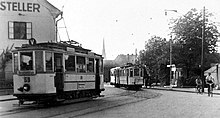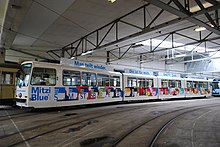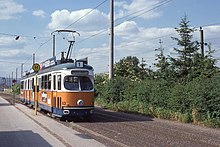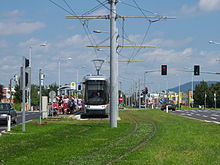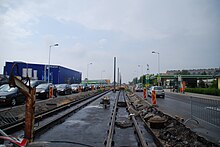Tram Linz
| Tram Linz | |
|---|---|
| Cityrunner 013 in the solarCity -Zentrum stop | |
| Basic information | |
| Country | Austria |
| city | Linz |
| opening | 1880 |
| operator | Linz lines |
| Transport network | Upper Austrian transport association |
| Infrastructure | |
| Route length | 30.4 km |
| Gauge | 900 mm |
| Stops | 68 |
| Tunnel stations | 3 (Central Station, Union Crossing, Sacred Heart Church partially, in a low position) |
| Depots | 2 (Remise Kleinmünchen, Remise Weingartshof) |
| business | |
| Lines | 5 (1, 2, 3, 4 and the Pöstlingbergbahn (50)), plus 2 night lines (N82 and N84) |
| Clock in the peak hours | 7.5 / 3 minutes (when engaged) |
| Clock in the SVZ | ~ 30 |
| vehicles | 56 " Cityrunner " low-floor cars 4 "Mountainrunner" low-floor cars 3 high-floor Pöstlingbergbahn cars 1 work car Various historical cars |
| Graphic line plan | |
The Linz tram forms the backbone of local public transport in Linz , the capital of Upper Austria . It runs on the rare gauge of 900 millimeters and is operated by Linz Linien , a division of the municipal Linz AG . Five lines operate , two of which have also served the municipalities of Leonding , Pasching and Traun since 2011 and 2016 respectively . The Pöstlingbergbahn has also been operationally integrated into the tram since 2009 . In addition to the tram, the city bus lines have been running since 1928 and the Linz trolleybus since 1944 .
Route network
The tram network essentially consists of a trunk line running in north-south direction , which is divided into different branches at both ends. The lines operate as follows:
| 1 | University - Auwiesen | Diameter line | 14.5 km | 35 stops | Furnishing operation |
| 2 | University - solarCity | Diameter line | 18.5 km | 44 stops | Furnishing operation |
| 3 | Landgutstraße - Traun intersection | Diameter line | 10.9 km | 23 stops | Furnishing operation |
| 4th | Landgutstrasse - Traun Castle | Diameter line | 12.7 km | 26 stops | Furnishing operation |
| 50 | Main square - Pöstlingberg | Radial line | 4.1 km | 14 stops | Bidirectional operation |
Much of the network is two-pronged. The only exceptions are a narrow point in the through-town of Ebelsberg , where a track loop was created, a 400 meter long section in Traun , and the Pöstlingbergbahn, which is served by line 50. A large part of the network runs on its own track structure, often on so-called " grass tracks ". In the area of the main station, the route is run as an underground tram in a tunnel.
In addition to the turning loops at the terminals Landgutstraße, Universität, Auwiesen, solarCity, Trauner Kreuzung and Traun Castle, the following operational loops also exist:
- St. Magdalena: operating loop
- Ferihumerstraße: turning loop for amplifier trips due to the increased number of passengers due to the discontinuation of the railway bridge
- Sonnensteinstraße: from 1969 to 1977 terminus of line 1, then used as a parking space for amplifier trains
- Central station north: intended for turning lines 1, 2 and 3 when the inner city line is interrupted, end point of line N84
- Central station south: from 2004 to 2011 terminus of line 3, today operating loop
- New world: from 1943 end point of the former line V, today operating loop
- Hillerstraße: from 2002 to 2005 the end point of line 2, today a loop
- Remise Kleinmünchen and
- Leonding-Weingartshof
The Linz tram currently has two depots:
- Remise Kleinmünchen : Wiener Strasse opposite Denkstrasse , continuously in operation.
- Weingartshof Remise : Leonding, Welser Straße next to the Doblerholz stop. In 2011 the parking facility was put into operation on the occasion of the extension of Line 3 to Leonding.
- Remise Urfahr : Landgutstraße near the Urfahr mountain railway station, shutdown in 1982, except for the administration building, all buildings and car sheds were demolished. Today the Remisenhof residential complex stands here .
A special feature was the level crossing of the tracks of lines 1 and 2 with the single-track, non-electrified Linz connecting line next to the railway bridge and Linken Brückenstraße. This crossing was removed because the railway bridge was demolished and the connecting line was dismantled.
Disused routes
- 1937 : from Landstraße / Blumauerplatz - Blumauerstraße - Friedhofstraße - Lenaustraße - Anastasius-Grün-Straße - to Wiener Straße. The line was built in 1917 in place of the level crossing in Wiener Straße with the Westbahn and shut down after the underpass was completed. This route was last used by lines E and V.
- 1968 : from Handel-Mazzetti-Straße / Weingartshofstraße - Handel-Mazzetti-Straße - Waldeggstraße - Stockhofstraße - Herrenstraße - Rudigierstraße - Mozartstraße - Weißenwolffstraße - to Garnisonstraße. This route was used by the M line.
- 1973 : from Wiener Straße / Spinnereistraße - Wiener Straße - to Fadingerplatz (rebuilt in 2002). This route was used by line E.
- 2001 : from Bahnhofstrasse / Volksgartenstrasse - Bahnhofstrasse - to Hauptbahnhof / Bahnhofplatz. This route was demolished in the course of the new construction of the main train station and state service center and relocated to Kärntnerstraße. It was last used by line 3.
- 2004 : above-ground route from Landstrasse / Scharitzerstrasse - Wiener Strasse - to Bulgariplatz. This route was last used by lines 1 and 2 until the underground route via the main station was opened.
- 2004 : above-ground route from Landstraße / Scharitzerstraße - Bahnhofstraße - Kärntnerstraße - to the main station (loop in the park). This route was used by line 3 until the underground route was opened.
vehicles
Current inventory

In mid-2012, the vehicle fleet consisted of 68 multiple units of four different types, 65 of which were low-floor :
| number | image | Numbers | Years of construction | Type | Manufacturer | low-floor | design type | annotation |
|---|---|---|---|---|---|---|---|---|
| 33 |

|
001-033 | 2002-2008 | Cityrunner , first generation | Bombardier Transportation | Yes | One-way vehicle | |
| 29 |

|
060-082 083-088 |
2011–2012, 2015 |
Cityrunner, second generation | Bombardier Transportation | Yes | One-way vehicle | The first 23 railcars were procured to replace the 3rd generation articulated railcars and to expand the route network to Leonding. It was necessary to reorder a further six railcars due to the extension to Traun. |
| 4th |

|
501-504 | 2009-2011 | Mountain runner | Bombardier Transportation | Yes | Bidirectional vehicle | 501-503 were delivered in 2009, 504 was ordered in 2010 and delivered in 2011 |
| 3 |

|
VIII, X, XI | 1948-1959 | IT G | No | Bidirectional vehicle | All three vehicles were modernized in 2009 and retraced from 1000 to 900 millimeters | |
| 1 |

|
A. | 1954 | IT G | No | Bidirectional vehicle | Work car | |
| 1 |

|
TW 6, BW 111, 109 | 1950 | SGP / ESG | No | Bidirectional vehicle | Last generation two-axle railcar with 2 sidecars; for special trips |
The four mountain runners delivered in 2009 and 2011 for the Pöstlingbergbahn are a variant of the city runner. The purchase price of the 23 second generation Cityrunners was around 69 million euros.
Former inventory
Two-axle vehicle with a sidecar
There used to be a number of different two-axle railcars and sidecars, many of which were built by ESG. The last series was retired when the third articulated wagon series went into operation in 1985/86. At least one three-car train from the last series was preserved for museum purposes and special trips.
First articulated wagon series
The seven six-axle articulated railcars of the first series correspond structurally to the Duewag standard car and were built by the Lohner works between 1970 and 1972 . They had road numbers 61 to 67 and were extended to eight-axle vehicles in 1973 and 1974. In 2004 it was shut down, among other things because retrofitting for use in tunnels was no longer profitable. Until there were enough city runners available, they were allowed to drive in the tunnel with a special permit. All cars in this series have now been scrapped, most recently with railcar 64 in 2016.
Another eight cars, which were eight-axle vehicles from the start, followed in 1971 and 1972 with road numbers 81 to 88.
Second articulated wagon series
The second articulated car series consisted of twelve eight-axle vehicles built in 1977 by Bombardier- Rotax and Siemens. They had road numbers 68 to 79 and were extended to ten-axle vehicles in 1979 and 1980. All cars in this series were scrapped in 2008.
Third articulated wagon series
The third generation of articulated trams consisted of 16 ten-axle vehicles with the numbers 41 to 56. They were related to the 600 series of the Graz tram , were built in 1985 and 1986 by Bombardier and Siemens and were the last high-floor trams on the Linz tram. They differed from their two predecessor series primarily in their angular design. All vehicles were scrapped in 2011 and 2012 after they were also replaced by more modern low-floor vehicles.
business
The Linz tram drives on sight, there are only block signals in the tunnel .
The trains usually run from 4:00 a.m. to 12:00 p.m. From February 27, 2009 to December 11, 2016 there was a night line called N1, which ran in the early morning hours between 0:00 and 4:00 on Saturdays, Sundays and public holidays every 30 minutes. It was on route 1. Since December 17, 2016, routes N82 and N84 have been operating at the same interval at this time. You take the route of line 2 (University - solarCity) or the south branch of line 4 (main station - Traun Castle).
In 1995/96, a computer-controlled operations control system (RBL) was gradually put into operation. This not only monitors the tram lines, but also all bus and trolley bus lines. All buses and trams report their current position via radio to the control center in Fichtenstrasse (originally in Kleinmünchen), which then has an overview of the current operating situation. The information from the AVL is also used for dynamic passenger information (DFI) at the stops: displays show the waiting time until the next tram or bus arrives separately for each line.
history
The beginnings of the Linz tram go back to 1880, when a horse-drawn tramway from the main train station, then known as the "Westbahnhof", was opened to Urfahr to today's Hinsenkampplatz. In 1895 the horse tramway to the Mühlkreisbahnhof was extended.
In 1897 the tram was electrified. In the following year, the Pöstlingbergbahn, which was electrically operated from the start, was opened.
Soon after electrification, the tram project from Blumauerplatz to Ebelsberg was tackled. In 1902 the initially single-track line was opened. However, it ended on the north side of the wooden Traun Bridge in Kleinmünchen , because the latter was not suitable for the heavy tram cars. With this network expansion, the long north-south line was created along which the city continued to develop and which earned it the nickname Linz on the Tramway .
Shortly before the outbreak of the First World War, the cross line, the later line M , from Waldeggstrasse to Weißenwolffstrasse was opened. This partially single-track line crossed the north-south line at the Mozart Crossing. In 1919 it was extended to the east as far as Garrisonstrasse, where former barracks were converted into residential buildings. In 1932 there was a short extension to the west into Handel-Mazzetti-Straße.
In 1919 line signals were introduced for better orientation: “B” (station line) for the Bergbahnhof Urfahr – Hauptbahnhof line, “E” for the line to Ebelsberg and “M” (M = Mozartstraße) for the cross line. For details, see section Line designations .
As early as 1917, the line to Ebelsberg was moved in the area of the intersection with the Westbahn from Wiener Strasse to a newly built underpass at Friedhofstrasse (cemetery line). When an underpass was built in Wiener Strasse in 1937, line E could be relocated back again.
With the construction of a new bridge over the Traun in Kleinmünchen, the tram could finally be extended to Ebelsberg in 1929. A direct rail connection to the Florianerbahn was established at Fadingerplatz . For a while there were even direct tram sidecars (“ through cars ”) from Urfahr to Sankt Florian . The carriages of the Florianerbahn, on the other hand, could not run in the Linz tram network because they were too wide.
After the "connection" to the German Reich , the tram cars had to be adapted to the German regulations ( BOStrab ). In July 1938, the right-hand driving regulations were introduced in Linz. Because of the construction of the Hermann Göring works , the traffic on Wiener Straße rose sharply, which is why the Blumauerplatz – Neue Welt line was expanded to two tracks in 1943 and the first reversing loop in the Linz tram network was opened in the New World.
After the war ended, it took four months before the entire tram network could be used again. Traffic over the Nibelungen Bridge was hindered by the demarcation line between the American and Soviet occupation zones. Passengers had to walk through the American control at the south end and the Soviet control at the north end. The trams drove empty across the bridge.
The year 1968 brought the end of line M. It was in the way of individual traffic in some narrow streets , and the planned extension to the main train station was obviously avoided because of the need to cross the Linz local railway .
Despite the closure of the M line, 1968 did not mean the beginning of the end of the Linz tram. In that year, the first articulated multiple units were ordered from the Lohner works in Vienna and the modernization of the tram was initiated. New reversing loops had to be built for the use of the articulated railcars. In Urfahr, the Sonnensteinstraße loop was created, which also served as a transfer point to the bus routes going north. In Kleinmünchen, the loop was built on Spinnereistraße. Since the articulated railcars could not go through to Ebelsberg, a shuttle railcar made the connection.
In 1973, the construction of a new Traun Bridge began in Kleinmünchen. The tram connection to Ebelsberg was interrupted. The tram ended again for a short time on the north side of the bridge, then the Spinnereistraße – Traunbrücke line was discontinued. The Florianerbahn lost the direct tram connection, which favored their discontinuation.
1977 brought a significant expansion of the network. In the north, the new line from Sonnensteinstrasse to the university was opened. The residents of the St. Magdalena district and the students of the Johannes Kepler University now had a free connection to downtown Linz.
The next network expansions took place in the south. Initially, the Auwiesen district was served by tram from 1985. And after 29 years of interruption, the tram returned to Ebelsberg on April 2, 2002, via the end point at that time, Fadingerplatz, to Hillerstraße. On September 2, 2005, the extension of this route into the newly built solarCity was approved.
Before that, in 2004, the underground tram line under the main train station was put into operation as part of the “Linz local transport hub”. Since then, all tram lines have been running under the main station.
The Pöstlingbergbahn was integrated on May 29, 2009 : the mountain railway, which was built in meter gauge in 1897, was re-gauged to 900 millimeters between 2008 and 2009 and linked to the Linz tram network. Since then it has been served by the 4.140-kilometer line 50, which runs continuously to the main square in downtown Linz. On August 13, 2011, the section from the main train station to the Harter Plateau (municipality of Leonding ) to the provisional final stop in Doblerholz was released, and on February 25, 2016, it was extended to the Traun intersection. Line 4 between Landgutstraße and Traun Castle was opened on September 10, and corresponds to line 3 up to the Traun intersection.
Line names
The first forerunners of line signals came from 1895 after the extension to the Mühlkreisbahnhof. Since only every second car drove to the Mühlkreisbahnhof, the cars were marked as follows:
- White disc: Staatsbahnhof – Mühlkreisbahnhof
- Red disc: Staatsbahnhof – Rudolfstrasse
Letter lines 1919–1974
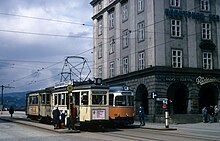
The first line signals in today's sense were introduced in 1919.
- Line B (station line)
- Urfahr mountain station – Linz main station
- Line E (Ebelsberg)
- Until 1929: Urfahr-Traunbrücke mountain station in Kleinmünchen
- From 1929: Urfahr – Ebelsberg mountain station
- From 1969: Sonnensteinstrasse – Ebelsberg
- From 1972:
- with articulated railcar : Sonnensteinstrasse – Spinnereistraße with connection to the shuttle railcar Spinnereistraße – Ebelsberg.
- HVZ amplifier trains with two-axle wagons: Sonnensteinstraße – Spinnereistraße – Ebelsberg.
- From 1973/74: Sonnensteinstraße – Spinnereistraße
- Line M (Mozartstrasse)
- Until 1919: Waldeggstraße – Weißenwolffstraße (at the deaconess hospital / Hyrtlstraße)
- From 1919: Waldeggstraße – Weißenwolffstraße (at Prielmayerhof / Garnisonstraße)
- From 1932 to 1968: Weingartshofstrasse – Weißenwolffstrasse
In addition to line E, there were also a few short lines, some of them as repeaters only during rush hour. They were named after their southern end point V (supply house, located near today's reversal loop in the New World ), H (Herz-Jesu-Kirche) or K (Kleinmünchen). The periods in which the lines V and H operated are not recorded.
- Line V (supply house)
- Until 1928: Blumauerplatz supply house
- Line V does not appear to have existed between 1928 and 1937.
- From 1937: Urfahr mountain station - supply house
- From 1943: Urfahr – Neue Welt mountain station
- From 1969: Sonnensteinstrasse – New World
- Line H (Herz-Jesu-Kirche)
- 1928 to 1937 (?): Blumauerplatz – Herz-Jesu-Kirche
- 1942 to 1943: Urfahr-Herz-Jesu-Kirche mountain station
- Line K (Kleinmünchen)
- 1971 to 1974: Sonnensteinstrasse – Spinnereistrasse
This short-lived line corresponded to line E, but had no connection to Ebelsberg. After the shortening of line E (no connection to Ebelsberg), the line signal K became superfluous. Line K was operated exclusively with articulated vehicles, especially since there were no K signal discs for the two-axle vehicles.
Number lines from 1974
In 1974 the entire line system, including bus and trolleybus lines, was converted to a uniform number system. Tram routes were given numbers from 1, bus routes from 10 and trolleybus routes from 40. Express bus routes with numbers from 70 and district bus routes with numbers from 100 were added later.
- line 1
Replaces line E.
- From 1974: Sonnensteinstrasse – Spinnereistrasse
- From 1977: Auhof – Spinnereistraße
- From 1985: University of Auwiesen
- Line 2
- 1974–1985: This line signal was initially used for various short tours of Line 1, for example Sonnensteinstrasse – Neue Welt or Sonnensteinstrasse – Remise Kleinmünchen. The destination could be taken from the destination sign. From 1985 a crossed out 1 was used for these short tours, that is, it was a so-called dashed line . From 2002 signal 2 was used for the extension to Ebelsberg.
- From 2002: Universität – Hillerstraße
- From 2005: University – solarCity
- Line 3
- From 1974: Urfahr mountain station – Linz main station
- From 2011: Landgutstraße-Doblerholz
- From 2016: Landgutstraße-Trauner crossing
- Line 4
- From 2016: Landgutstrasse-Traun Castle
Short tours and different routes
Before the introduction of matrix displays, line signals with line numbers crossed out were used for short tours and pull-in journeys . Since then, a star placed behind the line signal has shown short tours. A letter is appended to the line signal for journeys that leave the normal route. The following signals are used today:
- 1 * for short tours to Remise Kleinmünchen, Simonystraße, Sonnensteinstraße, Ferihumerstraße, St. Magdalena and Neue Welt (entry trips and amplifier trips in the Morgenspitze)
- 2 * for short tours to Hillerstraße, Remise Kleinmünchen, Simonystraße, Sonnensteinstraße, Ferihumerstraße, St. Magdalena and Neue Welt (Einrückfahrt and amplifier drives in Morgenspitze)
- 3 * for short tours to the main train station, Im Bäckerfeld and Doblerholz (on Sundays and public holidays and on arrival trips)
- 3a for driving in to the Remise Kleinmünchen, as well as in the other direction to Ferihumerstraße (amplifier trips in the morning on school days; from Rudolfstraße same route as line 1 *)
- 4 * for short tours to the main train station and Im Bäckerfeld (entry journeys)
Night lines
- Line N1 (discontinued)
- 2009 to December 2016: University - Auwiesen
Line N1 served line 1 during the night.
Line N82
- From December 2016: University - solarCity
Line N82 serves line 2 at night.
Line N84
- From December 2016: Central Station - Traun Castle
During the night, line N84 serves the route of line 4 without the section Landgutstraße - Hauptbahnhof. The timetables are designed so that it is possible to change from line N82 to line N83 at the main station without waiting.
Expansion projects
Extension of line 2 to Pichlinger See (in planning)
An extension of line 2 from solarCity to Pichling to the west bank of the Pichlinger See is planned , where it will establish a connection with the ÖBB station Pichling and the Pichlinger See. In the reversing loop in solarCity, the appropriate switches for an extension have been installed from the start. The realization is planned in two stages. The first stage is to connect the Linz Südpark to the tram network and also provide an opportunity to turn around there. The second stage should then be the extension to the swimming lake. According to Linz AG, they want to wait until the four-track gap between Kleinmünchen and the main train station, which currently prevents a 30-minute S-Bahn service between Linz and Sankt Valentin, has been completed. The construction work on the east side of Linz Central Station was completed in 2018, but the four-track expansion between the east side of Linz Central Station and Linz Kleinmünchen will probably only be implemented by 2026.
Extension of lines 3 & 4 to Traun (completed) and to Haid (in planning)
The realization of this project was planned in several stages from the beginning:
- Central station - Harter Plateau - Doblerholz
- Connections for branch tunnels have already been taken into account for the existing tunnel stop at the main train station. The 5.3 km long route initially runs underground to the Untergaumberg stop of the Linz local railway. After crossing under the Westbahn, the tram swings onto Kremstal Straße B 139, where a median was already kept free for the tram during the last road expansion (from the city limits of Linz to Weingartshof). The route leads over the Harter Plateau to the provisional terminus at Doblerholz. A few meters further above the UNO shopping center is the Weingartshof remise, which is equipped for 14 tram sets. There is also a reverse loop for line 3, but no public stop. Construction was originally planned to start in 2007, and the route should be opened in early 2009. In fact, construction began in March 2009 and the line opened on August 13, 2011.
- Doblerholz - PlusCity - Trauner Kreuzung - Traun Castle
- The second stage includes an extension along the Kremstalstraße ( B 139 ) to the lock Traun in Trauner center. The extension of the tram towards Traun Castle will be divided into two sections. The first section runs from the Weingartshof remise to the Traun intersection. Construction began as planned in April 2014. The extension went into operation on February 25, 2016. The second section to Traun Castle is used by the new line 4, which runs from the Landgutstraße stop to Traun. This section opened on September 10, 2016. Both lines run every 15 minutes on weekdays during the day, which results in a 7.5-minute cycle on the Landgutstraße - Trauner Kreuzung section. Another new feature is that tram line 4 to Traun is located between Traun Castle and the Traun intersection in an outer zone and therefore cannot be used with a Linz core zone ticket. For a journey from Linz to Traun or vice versa, a surcharge has to be paid to the core zone ticket.
- Traun Castle - Haid - Haid Center
- With the completion of the second stage, the current plans for the third stage to Ansfelden were also presented. It is to lead line 4 from Traun Castle via the main square in Haid, on to a new ÖBB stop along the Pyhrnbahn to a new end point directly at Upper Austria's second largest shopping center, the Haid Center. A precise period for the implementation of this extension has not yet been specified.
The main problem for the hesitant progress of the project was the varying degrees of willingness of the communities passed through to participate in the financing. This also resulted in a solution that made little sense from a transport policy point of view, that stage 1 in Leonding ended at the commercial area Kornstrasse / Edtstrasse at the Doblerholz stop. The UNO Shopping mall is almost a kilometer from there and the PlusCity mall is almost two kilometers away. Nevertheless, the opening was a success and the passenger forecasts were exceeded after a short time.
Extension of lines 1 and 2 in the north to the JKU Science Park
When the Stadt-Regio-Tram is realized ![]() from Linz via Gallneukirchen to Pregarten, a transfer point with a Park & Ride facility is to be built in the area of JKU Science Park 4 . There are plans to extend tram lines 1 and 2 to this transfer point.
from Linz via Gallneukirchen to Pregarten, a transfer point with a Park & Ride facility is to be built in the area of JKU Science Park 4 . There are plans to extend tram lines 1 and 2 to this transfer point.
Extension of line 1 in the south to Franzosenhausweg
The project to extend line 1 to Linz-Wegscheid station was abandoned at the end of 2004 due to difficulties in replacing the route and the resulting additional costs. In 2013, a southern extension of Line 1 was considered again. According to the traffic concept in the local development concept Linz No. 2, the city of Linz intends to extend tram line 1 from the current terminus in Auwiesen to a new terminus on Franzosenhausweg including the construction of a P + R facility.
Discarded projects
- Among other things, an underground route for the tram under Landstrasse was considered, in the form of an extension of the existing tunnel under the main train station. The advantage of higher speed and the avoidance of frequent rail replacement services at events are offset by the disadvantage of higher operating costs and longer access routes. There would also have been an impact on the highway as a commercial street. Technically, the question of the location of the northern ramp was difficult to answer. On the main square , a bunker from the Second World War and the underground car park are in the way. Since Schmidtorstrasse south of the main square is too narrow for a ramp, the tram would have to be led through at a great depth under the main square garage, which also requires an underground crossing of the Danube in the tunnel. After that, she could have passed under Hinsenkampplatz and reappeared on Wildbergstrasse.
- It was proposed that lines 3 and / or 4 be extended as a city-regional tram on the stretch from the Mühlkreisbahn to Rottenegg. This would have meant a conversion of the previous Mühlkreisbahn to a tram, whereby the route from Rotenegg to Aigen-Schlägl would have been discontinued. This option was later discarded in favor of a connection between the Mühlkreisbahn and the main train station via a tram route to be built. The Mühlkreisbahn, which has been extended in this way, is to be integrated into the Upper Austrian S-Bahn network as the S6 .
- Up to 2019 there were plans to build a new rail axis (Neue Eisenbahnachse Linz - NSL) east of the previous main line, which would have run from Bulgariplatz via Güterstrasse, Europaplatz, Gruberstrasse and over the New Danube Bridge Linz , which was built in place of the railway bridge . The tram should have run underground in the area from the Green Center to the new Danube bridge. A planned option was to build both a tram line (900 millimeters) and a standard gauge line (“three-rail track” or “four-rail track”) on the new Linz rail axis, whereby the standard-gauge line from the main train station to Gruberstrasse should have run in its own tunnel. In December 2019 it was announced that the city of Linz would have "waived" the construction of the new tram route; Instead, a standard-gauge urban railway line is to be built, which should become part of the Upper Austrian S-Bahn network . This tram should run from the main station via a new line to be built to the new Danube bridge. A junction is to be built in the area of Ferihumerstraße, with one branch to form the connection to the Mühlkreisbahn and the other branch as Regio-Tram should run via the JKU and Gallneukirchen to Pregarten.
literature
- Wilhelm Adam: The economic conditions of the Austrian trams in Vienna, Graz and Linz with special consideration of the tariff policy. Dissertation . Hochsch. for world trade, Vienna 1948, AC00774533 .
- Hans-Jürgen Zauner: The development of Linz and the transport company of ESG [Illustr.] Wirtschaftsswiss. Thesis . Linz 1972, AC08054053 .
- Hans Sternhart: Tram in Linz. Slezak, Vienna 1980, ISBN 3-900134-17-0 , AC01731286 .
- Peter Wegenstein, Friedrich Haftel (photo): The tram from Linz. (= Track in Fig. 59). Pospischil publishing house, Vienna 1987, DNB 211503487 , AC00221846 .
- Peter Wegenstein, Othmar Bamer (photo): The company Stern & Hafferl 3. This volume deals with the tram lines of Stern & Hafferl and the Pöstlingbergbahn. (= Track in Fig. 80). Pospischil Publishing House, Vienna 1991, AC00770301 .
- Gottfried Kuře: Linz on the tramway. 100 years of the electric tram. Verlag Johannes Heyn, Klagenfurt 1997, ISBN 3-85366-867-4 , AC02011442 .
- Christian Hager, Robert Schrempf: Linz is changing - the local transport hub. Central station, tram underpass, state service center. Denkmayr, Linz 2004, ISBN 3-902257-94-6 , AC04485290 .
- Wolfgang Kaiser: Trams in Austria . GeraMond Verlag, Munich 2004, ISBN 3-7654-7198-4 , AC03797375 .
- Author collective: Tram line Harter Plateau . LINZ AG (Ed.), Linz 2011, AC08840376 .
Web links
Individual evidence
- ↑ Linz StadtRegio-Tram reaches Traun Castle . In: Railway Gazette . Railway Gazette International , September 12, 2016, accessed September 14, 2016 .
- ^ Railway bridge: The course for new construction has been set. State capital Linz, September 2015, accessed on February 25, 2020 .
- ↑ Chronicle of the public transport system in Linz , accessed on April 6, 2020.
- ↑ a b Gottfried Kuře: Linz on the Tramway . Verlag Johannes Heyn, Klagenfurt 1997, ISBN 3-85366-867-4 , p. 172 .
- ↑ a b c Gottfried Kuře: Linz on the Tramway . Johannes Heyn Verlag, Klagenfurt 1997, ISBN 3-85366-867-4 , p. 161-163 .
- ↑ Limousine service! Chauffeur included. (PDF) Linz Linien, archived from the original ; accessed on February 25, 2020 .
- ↑ a b c d Safe through the night by bus, tram and taxi. Oberösterreichische Nachrichten, December 6, 2016, accessed on December 6, 2016 .
- ↑ Announcement of the Federal Ministry for Trade and Transport of April 14, 1929, regarding the granting of the concession for a continuation line from the end point of the narrow-gauge small railway Linz-Kleinmünchen to Ebelsberg, which is operated with electric power. Retrieved February 25, 2020 .
- ↑ Pichling tram line. Linz AG, accessed on August 10, 2020 .
- ^ ÖBB-Infrastruktur - Linz Central Station east side - All about the construction. ÖBB, accessed on August 10, 2020 .
- ↑ ÖBB work in Linz will continue for a few years. Oberösterreichische Nachrichten, December 21, 2018, accessed on February 25, 2020 .
- ↑ a b c traffic route plan of Linz AG Linien. Retrieved February 25, 2020 .
- ↑ The most beautiful Bim goes to Leonding. Oberösterreichische Nachrichten, July 10, 2011, accessed on February 25, 2020 .
- ↑ From now on the tram will travel to the Trauner Kreuzung. Oberösterreichische Nachrichten, February 25, 2016, accessed on February 25, 2020 .
- ↑ New tram brings many Linz customers to Plus-City. Oberösterreichische Nachrichten, August 10, 2016, accessed on February 25, 2020 .
- ↑ a b Tram should go to Science Park and be linked with a new light rail. Oberösterreichische Nachrichten, March 25, 2019, accessed on March 25, 2019 .
- ↑ Local development concept Linz No. 2. City of Linz, accessed on January 6, 2020 .
- ^ The Court of Auditors questions the route from Rottenegg. Oberösterreichische Nachrichten, March 2, 2013, accessed on June 28, 2013 .
- ↑ a b Linz dispensed with: Stadtbahn and trolleybuses are to replace the new tram axis. Oberösterreichische Nachrichten, December 14, 2019, accessed on December 14, 2019 .
- ^ Information on the press conference "Introduction of the Upper Austria S-Bahn with the ÖBB timetable change". State correspondence with media information, December 26, 2016, accessed on December 26, 2016 .




